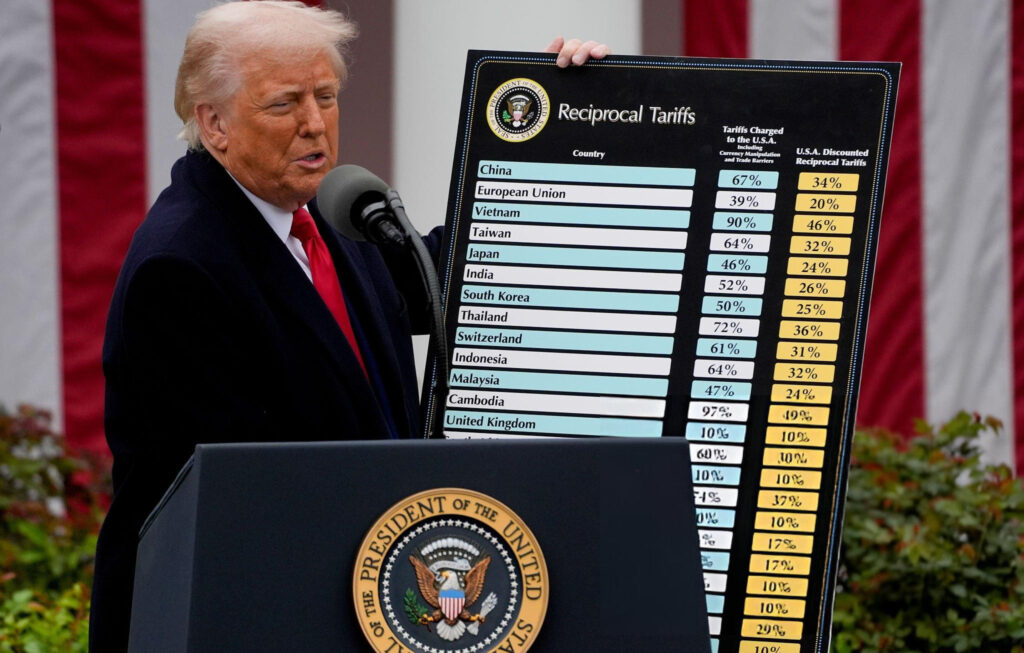Introduction: A Global Trade Shock
U.S. President Donald Trump, on August 6, 2025 said he would raise tariffs on Indian goods to levels that shocked traders across the global trade corridors to a stunning 50 percent rate on select items. The justification? India has been importing Russian crude oil and its push toward Brics which has recently increasingly been considered in Washington as a strategic competitor.

This was not just a policy problem to India, but a direct attack to its trade backbone. The U.S. is the largest exporter of the Indian country and the value of annual export is more than 86.5 billion. The tariff jolt is in the core of some of the labor-intensive and high-value industries, including gems and jewelry to pharmaceuticals, textile, electronics, and seafood.
Prime Minister Narendra Modi shot back with his hard stand: India will never sacrifice the interest of the farmers, artisans or workers. We will confront any repercussions to protect our sovereignty and the livelihood of our people.
What does such a daring position imply in practice? What are the bleeding industries? What will be the rebalancing of the Indian economy? This article is probing.
1. Understanding the Tariffs: What Has Changed?
The 50% tariff declaration is a union of newly imposed levies on high of the current levies, on major export categories in India. The duties on some industries such as jewelry, processed seafood, pharmaceuticals, and electronic components have now been increased to twice their 2024 levels.

Tariffs by category (before vs after):
| Product Category | 2024 Tariff Rate | 2025 Effective Tariff |
|---|---|---|
| Gold Jewelry | 20% | 50% |
| Smartphones & Electronics | 10–15% | 40–50% |
| Shrimp & Seafood | 25% | 50% |
| Auto Components | 12% | 35% |
| Generic Pharmaceuticals | 5–10% | 25–35% |
| Garments & Textiles | 16.5% | 45–50% |
The argument presented by Trump depends on the oil relations that India has with Russia as well as perceived non-adherence to Western directed sanctions. Yet, analysts view this as equal parts muscle-flexing by potential economic action before the 2026 U.S. midterms, as it is on a foreign policy front.
2. The Numbers Game: India’s Export Economy to the U.S.
In 202425, the volume of goods shipped to the U.S. was 86.5 billion dollars exported by India. India has its largest trading partner in the U.S. since almost all of the Indian exports comprise nearly 18%.
Top 10 Export Items to the U.S. (FY24):
| Export Sector | Value (in $ billion) |
|---|---|
| Pharmaceuticals | 7.5 |
| Diamonds & Jewelry | 11.9 |
| Textiles and Garments | 9.2 |
| Engineering Goods | 12.3 |
| Auto Components | 2.8 |
| Seafood | 2.0 |
| IT Hardware & Electronics | 14.4 |
| Leather Products | 14.4 |
| Organic Chemicals | 1.6 |
| Iron and Steel Articles | 1.1 |
According to Federation of Indian Export Organisations (FIEO), 55 percent of these exports are expected to have an immediate impact which would mean a possible loss of $26-30 billion in FY26.
3. Sectoral Deep Dive: Who Gets Hurt the Most?
A. Gems & Jewelry (11.9 billion)
- The U.S. believes in India as its market leader in cut and polished diamonds.
- Indian jewelry is 20-30 percent more expensive than its competitors (Thailand and Israel) due to tariffs.
- Operations in polishing units in Surat which employ a total of 200,000 workers are being threatened by the fear of being laid off when the orders run dry.
- It has gone to the WTO that was intervened by GJEPC (Gem & Jewellery Export Promotion Council).
B. Pharmaceuticals (7.5 billion)
- More than 40% of generics in the U.S. are supplied by India.
- Formulations are possible targets of higher tariffs, but APIs (active pharmaceutical ingredients) fall into a relatively safe category.
- The U.S. FDA has been putting more plants in India under scrutiny, creating additional regulatory barriers to tariffs.
- 6-8% is the decline in the share price in the cases of Biocon, Sun Pharma and Cipla after the tariff announcement.
C. Textiles & Apparel (9.2 billion)
- Very labor intensive; the majority of these units are MSMEs.
- Competition to Bangladesh and Vietnam which have preferential U.S duties.
- In Tiruppur and Ludhiana, exporters are experiencing cancellation of their orders as well as renegotiations.
- The garment manufacturing hub of Tamil Nadu is now demanding the central subsidy to cover up the new cost.
D. Exports seafood (2.0 billion)
- Shrimps in India are killed by tariffs.
- The major producers- Andhra Pradesh Gujarat and Odisha- are preparing to lose Rs 24,000 crore.
- Presently, it is most probable that the U.S. will receive more imports of Ecuadorian, Thai, or Vietnamese imports.
- Marine Products Export Development Authority (MPEDA) has promoted finding alternative markets in Japan and UAE
E. Electronics & Smartphones (14.4 billion)
- In H1 2025, India even shipped more than $4.2 billion worth of iPhones and mobile component exports to the U.S.
- Apple carries out its supply chain known as Make in India through Foxconn and Tata electronics, both of whom are impacted by tariffs.
- This is an area of concern to analysts that India could be lagging behind in its dream to become the next electronics hub.
- The incentives under the PLI Scheme may now be required to overcome the shock.
F. Auto Components (2.8 billion)
- The Pune, Chennai, and Manesar auto parts industries export essential components of gearboxes, clutches, and engine components to U.S. car companies.
- Mexican and East European Supplier Competition.
- ACMA (Auto Component Manufacturers Association) forecasts a decline between 12-15 percent in FY26 revenue in North America.
4. MSMEs in Crisis: India’s Factory Backbone Trembles
Over 65% of Indian exporters that were hit by the new tariffs are in the MSME sector.
- Leather tanneries, embroidery houses, seafood processors and smaller textile units are dependent on the American market.
- When the margins are already wafer-thin, an increase of a quarter in costs will result in overnight loss of global competitiveness.
- International trade body FIEO forecasts more than 10 lakh (1 million) jobs would go in the direct line as soon as the tariffs are not relaxed or rolled back.
Ground Reality:
“We had orders from California worth $150,000 this quarter. The client now wants a 30% rate cut. We can’t survive this,” says Mohanlal Khemka, a leather exporter from Kanpur.
5. Political Response & Diplomatic Fallout
India’s Response:
- PM Modi positioned it as a sovereignty and welfare of the farmers test.
- The Ministry of external Affairs (MEA) released five point refutation focusing on:
- The Indian oil commerce with Russia is not idealistic but market-oriented.
- The Weights and Measures Acts of the U.S. contravene the MFN of WTO.
- Diplomatic visits to China and South Africa have been expedited to determine economic cushions under BRICS.
U.S. Political Intentions:
- One area where the Trump administration is visibly targeting India is by accusing it of weakening Western powers towards Russia.
- This is an issue being amplified in swing states where large populations of farm and steel workers live.
6. Economic Forecasts & Strategic Shift
How GDP and trade deficit affect:
- The export contraction could cost India a 0.3-0.4 percent of its GDP during every year.
- Our trade deficit with the U.S. might narrow-but only through collapsing exports, not through rising domestic production.
Possible Recovery Levers:
- Multiple Markets: Target ASEAN, EU, Africa and Latin America, to reduce the U.S. dependence.
- Currency Buffer: Downswing is giving the INR (~3.4% decline since tariff) which could give temporary competitive picks.
- Increase PLI: Production Linked Incentive plans need adjustment to counter global risk.
- FTA Fast-Tracking: Trade negotiations between India-EU and India-UAE should be brought on fast-track.
7. The Road Ahead: Navigating a Trade Quake
The tariff increase is not a skirmish. It is a preliminary vibration in a reconfigured international commerce structure, where financial blackmail has become one of the regularly utilized apparatus.
Whether India can survive and fight against this challenge will be determined by:
- Strategic diplomacy
- Trade diversification
- Scattering scale-up in the US
- And the last of all, political unity not only across the federal but industrial lines
From Reaction to Reinvention
India is at a crossroads. The tariffs floated by the U.S. are bigger than a trade war; they symbolize a trial of strategic resolve, economic dexterity, and policy swiftness of India. The big words now need to be met by good institutional backing of the exporters, worldwide alliance-making, and specific stimulus at home, that is, by Prime Minister Modi.










